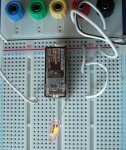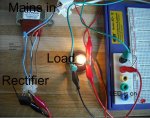Minifig666
Senior Member
Hello,
I know this isn't a very PICAXE related project but it may be involving a PICAXE later...
What I want to do is have a relay to switch on and off at no more than 10Hz. I understand there is a way to do it by charging and discharging a capacitor but all of my attempts so far have been fruitless. All I have been able to do is have it act as a standard relay 'vibrator' but for a short amount of time until the capacitor is fully charged. Does anyone have a schematic to make this work?
Thanks in advance.
I know this isn't a very PICAXE related project but it may be involving a PICAXE later...
What I want to do is have a relay to switch on and off at no more than 10Hz. I understand there is a way to do it by charging and discharging a capacitor but all of my attempts so far have been fruitless. All I have been able to do is have it act as a standard relay 'vibrator' but for a short amount of time until the capacitor is fully charged. Does anyone have a schematic to make this work?
Thanks in advance.


